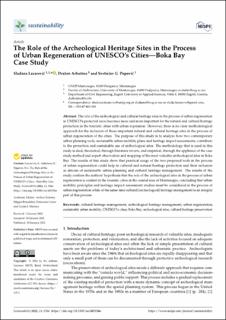| dc.contributor.author | Lazarevic, Sladjana | |
| dc.date.accessioned | 2023-01-23T15:07:02Z | |
| dc.date.available | 2023-01-23T15:07:02Z | |
| dc.date.created | 2023-01-21T10:48:46Z | |
| dc.date.issued | 2022 | |
| dc.identifier.issn | 2071-1050 | |
| dc.identifier.uri | https://hdl.handle.net/11250/3045452 | |
| dc.description.abstract | The archaeological and cultural heritage sites' role in urban regeneration in UNESCO’s protected areas becomes increasingly important for natural and cultural heritage protection in tourist cities with urban expansion. However, there is no straightforward methodological approach for the inclusion of these important natural and cultural heritage sites in the process of urban regeneration of the cities. This study aims to analyze how two contemporary urban planning tools, sustainable urban mobility plans and heritage impact assessments, contribute to archaeological sites' protection and sustainable use. The methodology used in this study is dual, theoretical, through literature review, and empirical, through the appliance of the case study method and expert observation and mapping of the most valuable archaeological sites in Boka Bay. The results of this study show that practical usage of the two proposed tools in the urban regeneration projects could help in cultural and natural heritage protection and their inclusion as drivers of sustainable urban planning and cultural heritage management. The results of the study confirm the authors’ hypothesis that the role of the archaeological sites in the process of urban regeneration is evident in the touristic cities in the coastal area of Montenegro, concluding that urban mobility principles and heritage impact assessment studies must be considered in the process of urban regeneration while at the same time, cultural (archaeological) heritage management is an integral part of this process. | |
| dc.description.abstract | The Role of the Archeological Heritage Sites in the Process of Urban Regeneration of UNESCO’s Cities—Boka Bay Case Study | |
| dc.language.iso | eng | |
| dc.publisher | MDPI | |
| dc.rights.uri | http://creativecommons.org/licenses/by/4.0/deed.no | |
| dc.subject | Bytransformasjon | |
| dc.subject | Urban regeneration | |
| dc.subject | Kulturarv og kulturminner | |
| dc.subject | Cultural heritage | |
| dc.title | The Role of the Archeological Heritage Sites in the Process of Urban Regeneration of UNESCO’s Cities—Boka Bay Case Study | |
| dc.title.alternative | The Role of the Archeological Heritage Sites in the Process of Urban Regeneration of UNESCO’s Cities—Boka Bay Case Study | |
| dc.type | Peer reviewed | |
| dc.type | Journal article | |
| dc.description.version | publishedVersion | |
| dc.subject.nsi | VDP::Urbanisme: 237 | |
| dc.subject.nsi | VDP::Urbanism: 237 | |
| dc.subject.nsi | VDP::Urbanisme: 237 | |
| dc.subject.nsi | VDP::Urbanism: 237 | |
| dc.subject.nsi | VDP::Urbanisme: 237 | |
| dc.subject.nsi | VDP::Urbanism: 237 | |
| dc.subject.nsi | VDP::Urbanisme: 237 | |
| dc.subject.nsi | VDP::Urbanism: 237 | |
| dc.source.journal | Sustainability | |
| dc.identifier.doi | 10.3390/su14031566 | |
| dc.identifier.cristin | 2112467 | |
| cristin.ispublished | true | |
| cristin.fulltext | original | |
| cristin.qualitycode | 1 | |

